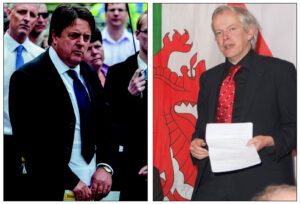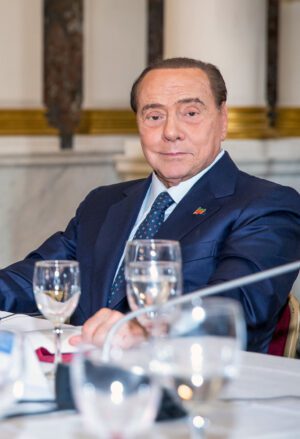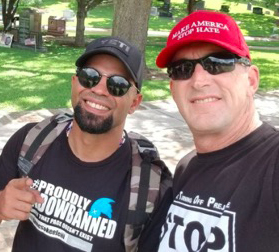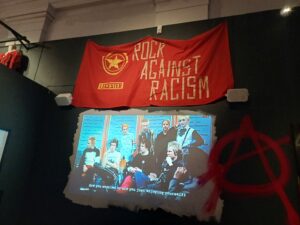
Downhearted Nick Griffin (left) and Peter Rushton (right)
Images credit: Griffin (Searchlight) Rushton (Heritage and Destiny website)
Two of the far right’s most influential figures have been perusing the movement’s recent local election disaster in May and have come to radically different – although similarly scathing – conclusions. Mark Scholl considers their deliberations
The first figure in question is self-styled nazi ‘intellectual’ Peter Rushton, deputy editor of Heritage and Destiny, whose ability to construct grammatically complete sentences sets him apart from most of his comrades. The other is former British National Party (BNP) leader Nick Griffin, now holed up in Wales making a very decent living from marketing religious nuttery online. Both are very extreme even within their own circles, and both are given to Holocaust denial and anti Semitic conspiracies.
But first a recap: in May, far-right parties across the country managed a handful of utterly derisory votes in local council elections. Even their best results were pathetic: for example, Ashlea Simon in Walken North and Julian Leppert in Waltham Forest Paternoster Ward both failed miserably. The former had stood for Britain First and the latter for the British Democratic Party (BDP).
Simon’s vote was down, despite a campaign dating back many months to which her party had devoted considerable time and resources. And Leppert, who won a seat for For Britain in 2020 but was this time contesting it for Andrew Brons’s BDP, was turfed out.
One of the elephants in the far right recreation room is addressed by Rushton, who has launched an unprecedented and vitriolic attack on, well, just about everyone in the movement. In a furious article entitled ‘Time for nationalists to decide – are we serious?’, published on the Heritage and Destiny website, he fires off in all directions. The results, he says, reflect, ‘… years of decline, years of factional division, years of vanity, years of crank obsessions, years of tolerating substandard conduct within our ranks’.
Why, he moans, have so many activists been drawn into futile single-issue campaigning. ‘Why are many nationalists in 2023 happier to protest about drag queens, or go on marches to promote conspiracy theories about Covid, while seeming to lose interest in serious racial nationalism – especially the essential hard slog of election campaigning? … questions need to be asked as to why so many nationalists are happier on social media than on doorsteps. This applies to civic nationalists in Reform UK, UKIP and its splinters, even more than to racial nationalists.
‘Part of the problem is defeatism, engendered by a style of politics that overemphasises conspiracies and the presumed power of our enemies.’
‘Un-British’ crankery
For once, he has a point. Rather than going out canvassing and arguing politics on the doorstep over and over again, it is much more fun attending big rallies in Trafalgar Square to hear unhinged speakers such as Kate Shemirani demand that doctors and nurses face the death penalty. Much easier to promote anti-globalist fear-mongering via a New Age ‘anti-system’ ideology than leaflet housing estates. Much simpler to direct people to conspiracists such as David Icke online.
Rushton’s problem is that in 2023, as we are finding out, there are many avenues for such conspiracy-based expression. Rushton knows that his Heritage and Destiny operation now has serious competition, which is threatening to wipe him out. One of the issues that he identifies is that potential recruits want easy answers to difficult problems – this from a man who has stood on platforms with the most extreme dregs of Europe’s far right: Michele Renouf, Manfred Roeder and Isabel Peralta.
He believes that there are too many cranks within the far right and, again, he is right. In fact, it is stuffed with them. But he wants his cranks to stick to strictly ‘racial nationalist’ crankery.
Responding to the election results, Rushton concludes: ‘Tragically what we are left with in 2023 is a movement … abandoning serious ideology to pursue crank fads (often imported online from the USA) that are of no relevance to the racial nationalist cause, but also have no substantial appeal to the British electorate.’ He then adds: ‘Three good examples are a trio of intellectually flimsy, un-British, indeed anti-British and anti-European political cults: Trumpism, anti-vaxxism, and Putinism.
‘But once any or all of these cults infect a nationalist party or movement, they become a toxic threat to our cause. The vast majority of British voters will never believe that CoViD vaccinations were a mass poisoning plot; they will never take Donald Trump seriously; and they will never support Putin’s semi -Asiatic hordes.’
So, let’s have purely British crankery from now on, please.
Rushton often cites the success of parties in Europe, but in Europe their mainstreaming – that is, the extent to which the far right’s clothes have been forced upon or stolen by popular, established and ostensibly more respectable conservative parties – has been a highly effective strategy. Hence there has been huge progress for parties from Finland to Italy. Several now have serious political power and influence.
Indeed, one of its most successful exponents, Italy’s Prime Minister Giorgia Meloni, a ‘former’ fascist activist, combines anti-immigrant rhetoric with a National Conservative ideology funded by big business.
Yesterday’s men
This success must drive Griffin and Rushton crazy because they are now threatened with being surplus to requirements, yesterday’s men whose political ideology and tactics are increasingly irrelevant, squeezed between rightward moving conservative parties and deranged conspiracy cults.
Seasoned observers will not perhaps be surprised that Griffin should survey the election wreckage and also draw negative conclusions. For him, the results show that ‘… there is no electoral road … The idea that any existing party will be in a position even to match the electoral capabilities of the old BNP in under ten years from now is ridiculous’.
But he has not reached this conclusion solely because electoral realities have hit home. Oh, no. He, along with Jim Dowson, a former BNP fundraiser now with Britain First, and Jayda Fransen, formerly of the EDL now with the British Freedom Party, are promoting a ‘religious battle against Islam’. This is a pseudo-Knights Templar operation that combines mysticism with old-style religious bigotry to lure supporters – and their money – from across Europe.
One thing we do know about Dowson is that he is a highly successful fundraiser, and this operation is a real moneyspinner. Some of these religious extremists who, interestingly, come from both Protestant and Catholic backgrounds, have gained traction in Hungary and Spain. Dowson, of course, previously raised money for many far-right groups both in the UK and Europe, as well as for anti-Muslim border patrols in Eastern Europe.
But none of his filthy lucre will be going into elections, that’s for sure. They’re history, says Griffin. Indeed, why go out on the stump when you can sit back and watch the money come rolling in? And, when it is rolling in, why throw it all down the pan? Griffin’s justification is that the tactics he used to win council seats for the BNP back in the day are no longer relevant because of demographic factors, apathy, movement divisions and tactical mistakes.
Griffin now talks up parties such as Reclaim and Reform, both of which are much better funded than any of the microscopic far-right parties that grew out of the BNP ten years ago.
In a video uploaded to Dowson’s purged.tv platform, he says that he believes any votes for anti-immigrant patriotic policies will, in future, go to Laurence Fox’s Reclaim Party, with voters unlikely to vote for openly fascist politics when there is a slightly more respectable option. And that, of course, would be a big problem for Paul Golding, Andrew Brons, Mark Collett and the Homeland Party. A cynic might suggest that Griffin’s main motive is resentment at the over £5 million given to Reclaim by businessman Jeremy Hosking.
No complacency
Nevertheless, as Griffin points out, given the massive support offered to both Reclaim and Reform UK on the GB News channel, both should be doing considerably better than they are. Anti-migrant hostility has been whipped up by the media, particularly the Daily Mail and Daily Express newspapers. Migrants are, like the immigrants of earlier decades, being blamed for everything.
But even so, apart from six seats in Derby for Nigel Farage’s Reform UK, all was failure. Both Reform UK and Reclaim did appallingly badly in the recent elections, to the extent that many of their people must be wondering why they are carrying on.
The good news is that the British far right is more divided than ever. The paltry votes received in May are further evidence of this. Even so, there is no room for complacency. Searchlight will be keeping a very close eye on the mainstreaming movement, efforts to infiltrate the Conservative Party, the conspiracy fantasists and the formation of violent proto-terrorist anti-system-type groups, all of which can be born of electoral failure and political desperation. Because, while Griffin and Rushton rue their failures, others are preparing to step forward …





